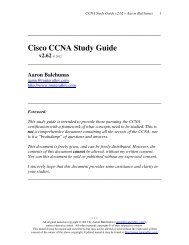Open Shortest Path First (OSPF) - Router Alley
Open Shortest Path First (OSPF) - Router Alley
Open Shortest Path First (OSPF) - Router Alley
You also want an ePaper? Increase the reach of your titles
YUMPU automatically turns print PDFs into web optimized ePapers that Google loves.
<strong>OSPF</strong> v1.31 – Aaron Balchunas<br />
4<br />
<strong>OSPF</strong> Designated <strong>Router</strong>s<br />
In multi-access networks such as<br />
Ethernet, there is the possibility of<br />
many neighbor relationships on the<br />
same physical segment. In the above<br />
example, four routers are connected<br />
into the same multi-access segment.<br />
Using the following formula (where<br />
“n” is the number of routers):<br />
n(n-1)/2<br />
…..it is apparent that 6 separate adjacencies are needed for a fully meshed<br />
network. Increase the number of routers to five, and 10 separate adjacencies<br />
would be required. This leads to a considerable amount of unnecessary Link<br />
State Advertisement (LSA) traffic.<br />
If a link off of <strong>Router</strong> A were to fail, it would flood this information to all<br />
neighbors. Each neighbor, in turn, would then flood that same information to<br />
all other neighbors. This is a waste of bandwidth and processor load.<br />
To prevent this, <strong>OSPF</strong> will elect a Designated <strong>Router</strong> (DR) for each multiaccess<br />
networks, accessed via multicast address 224.0.0.6. For redundancy<br />
purposes, a Backup Designated <strong>Router</strong> (BDR) is also elected.<br />
<strong>OSPF</strong> routers will form adjacencies with the DR and BDR. If a change<br />
occurs to a link, the update is forwarded only to the DR, which then<br />
forwards it to all other routers. This greatly reduces the flooding of LSAs.<br />
DR and BDR elections are determined by a router’s <strong>OSPF</strong> priority, which<br />
is configured on a per-interface basis (a router can have interfaces in<br />
multiple multi-access networks). The router with the highest priority<br />
becomes the DR; second highest becomes the BDR. If there is a tie in<br />
priority, whichever router has the highest <strong>Router</strong> ID will become the DR.<br />
To change the priority on an interface:<br />
<strong>Router</strong>(config-if)# ip ospf priority 125<br />
Default priority on Cisco routers is 1. A priority of 0 will prevent the router<br />
from being elected DR or BDR. Note: The DR election process is not<br />
preemptive. Thus, if a router with a higher priority is added to the network, it<br />
will not automatically supplant an existing DR. Thus, a router that should<br />
never become the DR should always have its priority set to 0.<br />
* * *<br />
All original material copyright © 2007 by Aaron Balchunas (aaron@routeralley.com),<br />
unless otherwise noted. All other material copyright © of their respective owners.<br />
This material may be copied and used freely, but may not be altered or sold without the expressed written<br />
consent of the owner of the above copyright. Updated material may be found at http://www.routeralley.com.

















